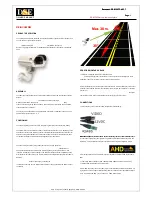
SEMI-AUTOMATIC OPERATION WITH UNCOUPLED LENSES/ACCESSORIES: REMINDERS
When using the stop-down metering system with uncoupled lenses or accessories, keep in mind that the
f/stopscale in the viewfinder no longer applies; neither do the under or over-exposure warning bands. If the
needle's above the Index Mark (39) as shown (above, left) there's not enough light; ff it's below this mark
(above, right)there's too much light. Solution: change lens aperture and/or shutter speed until the needle lines up
with the Index Mark.
In full-aperture metering with Konica Automatic Hexanon stray light which may enter the eyepiece and reach
the meter cells hay virtually no effect on exposures. In stop-down metering with uncoupled lenses or
accessories, however, such light can have the effect of incorrectly influencing the meter's reading. Whenever
you're using the stop-down metering system, be sure to place your eye as close as possible to the eyepiece, to
prevent stray light from entering. (A Konica Rubber Eyecup, available from your dealer, helps here.)
Using Preset Lenses....
Lenses of this type do not automatically close down to the desired aperture; you turn the aperture control ring
by hand to select the desired f/stop. Still, you can speed up operation considerably by setting both control rings
of these lenses to the
smallest
f/stop (f/22 in the example shown above), then turning them together until the
meter needle lines up with the Index Mark in the viewfinder. As soon as it lines up, you're ready to shoot . . .
HINTS FOR UNUSUAL EXPOSURE SITUATIONS
The through-the-lens metering system of your Konica Autoreflex-A3 provides consistently accurate exposures
under an amazing variety of lighting conditions. In some instances, however, it may be desirable to compensate
for unusual
Backlit Subjects:
See how the sun is shining towards the
camera in the illustration at the right? Chances are, the subject
will have a much more natural expression than she would if she
had to stare into the sun...but as a result, her fact is much darker
than the rest of the scene as seen by the camera. Solution walk
up to the subject, hold the camera close to the most important
part (her face), press the shutter release
halfway
down...and
you've "frozen" the meter needle at the correct
position. Holding the release button in place, step back, focus
and shoot: the exposure is actually taken at the aperture
indicated when you first depressed the release, as shown within
your Konica's viewfinder.











































